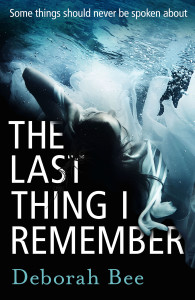Guest Post…Deborah Bee: Writing a Dual Narrative
 Two protagonists/dual narrative – rooky error or good plan?
Two protagonists/dual narrative – rooky error or good plan?
Why did I do it for my novel, The Last Thing I Remember. I don’t really know. It just seemed eventually (after two years of thinking about it) like a good idea.
Writing this blog piece, I just googled “a novel with two protagonists” and now I’ve been put off the very notion of a two-hander. Basic fiction writing, it says, warns against prologues, dream sequences, flashbacks, adverbs and dual/multiple protagonists. Oops. I’ve got some of them as well. And it says they are absolute rules. ABSOLUTE. RULES. Shriek.
The problem, it seems to be, is that apparently you can’t tell a compelling story if it’s split down the middle, UNLESS, each protagonist is equally weighted, with their own story arc that contains similar highs and lows, conflicts and resolve, leading to a balanced conclusion. But even if you do that, it’s never going to work.
I didn’t know that. I haven’t been to a creative writing class. I wish I had. But now I do know, I’m in the foetal position under my desk. I’ve made a rooky error. Are my protagonists equally weighted? Do they have similar highs and lows? All I know was that it was sodding complicated running two stories at the same time. Even though they are tightly woven together, I got lost so many times along the way.
Then there’s the dual narrative bit. Similarly, that’s considered a bad idea, mainly because it’s so easy to get confused over who is speaking. The received wisdom seems to suggest that unless the story calls for it, a dual narrative is a bit of a triumph of style over content. The secret to success…to create two utterly distinctive voices that cannot be confused.
So thinking about it, the reason I did a two-hander? Well, to start with my first protagonist, the one I really started with, is in a coma. She has Locked-in Syndrome. She can’t move, blink, see, swallow, breathe. However she can hear. And she can think. She can’t remember how she got there, but she’s piecing it all together by the conversations she can hear, and from her slowly-returning memory. The problem I created for myself was how to keep the audience interested in a woman who is totally stuck in her own head. She’s sad, frightened and desperately trying to grasp hold of her memories.
 Protagonist 2 then was really a pair of eyes. An undercover agent almost, who could describe life on the outside. Kelly is fourteen and should be the innocent of the piece. But right from the start we discover that she is far from innocent, far from her school-girl appearance. She’s mouthy. She swears constantly. She uses the wrong words. She’s funny. I wanted Kelly to be the antidote to Sarah.
Protagonist 2 then was really a pair of eyes. An undercover agent almost, who could describe life on the outside. Kelly is fourteen and should be the innocent of the piece. But right from the start we discover that she is far from innocent, far from her school-girl appearance. She’s mouthy. She swears constantly. She uses the wrong words. She’s funny. I wanted Kelly to be the antidote to Sarah.
The reason that a dual narrative was a useful structure – because Sarah can tell you things about Kelly that Kelly would never say. And vice versa. And both of them are fantastically unreliable witnesses.
Then, anyway. Along came Gone Girl. Two protagonists, dual narrative. It worked so well they made a film out of it. Rules out the window. It’s all her fault. Blame Gillian Flynn. You maverick Gillian Flynn. ABSOLUTE MAVERICK.
The Last Thing I Remember is published by Twenty7 Books and is available to download now: